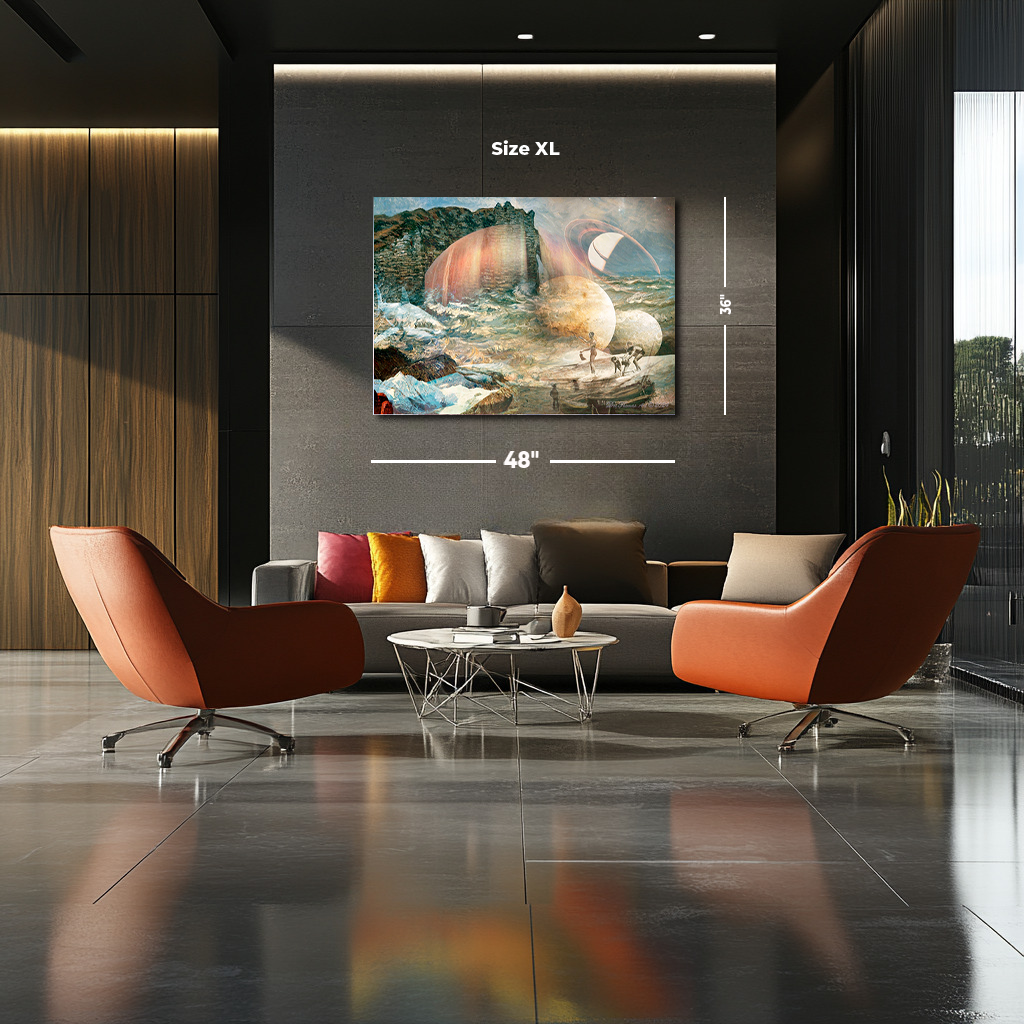Cosmic Tempest: Monet’s Étretat Reimagined Through Dadaist Wonder
"Cosmic Tempest" reimagines Claude Monet’s Stormy Sea in Étretat as a celestial spectacle blending terrestrial chaos with cosmic wonder. The stormy cliffs and waves of Étretat are bathed in the light of planetary bodies and Saturn’s rings, creating a surreal narrative of interconnected forces. Human figures, including playful children on the shoreline, add a poignant contrast to the grandeur of nature and the universe. This reinterpretation honors Monet’s mastery of light and movement while exploring themes of interconnectedness, awe, and the delicate balance between humanity, nature, and the cosmos.
Please see Below for Details…
Hotline Order:
Mon - Fri: 07AM - 06PM
404-872-4663
Claude Monet’s Stormy Sea in Étretat is a mesmerizing Impressionist masterpiece that captures the raw power and sublime beauty of nature. Painted in 1883 during Monet’s time in Étretat, a small coastal village in Normandy, this work showcases his ability to translate the energy of a turbulent sea into an evocative symphony of color and movement. The reinterpretation, "Cosmic Tempest," infuses Monet’s stormy coastline with surreal and Dadaist elements, blending terrestrial chaos with celestial wonder to create a multi-layered exploration of nature, humanity, and the infinite.
In Monet’s original painting, the dramatic cliffs of Étretat rise majestically over the stormy waters of the English Channel. The wild sea churns with energy, its waves crashing against the shore in a chaotic dance. Monet’s characteristic brushstrokes, loose yet deliberate, capture the ever-changing nature of the sea, while his palette of deep blues, greens, and foamy whites evokes the tempest’s intensity. The cliffs, steadfast and monumental, stand as a stark contrast to the sea’s restless energy, grounding the scene in a sense of permanence amidst the chaos.
In this reimagined piece, the stormy sea is transformed into a cosmic theater. Celestial elements, including planetary bodies and Saturn’s iconic rings, dominate the upper half of the composition, suggesting that the forces shaping the sea are tied to the universe’s vast, mysterious rhythms. The cliffs, still towering, are bathed in otherworldly light, blending their terrestrial presence with the ethereal glow of the cosmos. The stormy waves appear to ripple with cosmic energy, their movement echoing the gravitational pulls of the planets above.
The addition of human figures introduces a narrative dimension to the composition. Children play on the shoreline, their innocence and joy juxtaposed against the immense forces of nature and the universe. Their smallness in the face of the towering cliffs and expansive sea emphasizes humanity’s vulnerability and transience. Meanwhile, distant silhouettes of fishermen and boats tether the scene to reality, reminding viewers of the enduring relationship between people and the sea.
The color palette in this reinterpretation builds upon Monet’s mastery while introducing cosmic vibrancy. The stormy greens and blues of the sea remain central, representing vitality, chaos, and transformation. The warm, golden tones of the celestial bodies add a sense of awe and illumination, symbolizing the interconnectedness of all things. The soft, glowing hues of the planetary rings contrast with the darker shadows of the sea, creating a dynamic interplay of light and darkness that mirrors the duality of creation and destruction.
As an artist, this reinterpretation was inspired by Monet’s ability to capture both the majesty and fragility of nature. The inclusion of cosmic elements reflects a fascination with the universality of these themes—how the forces that shape our world are mirrored on a grander, cosmic scale. The decision to incorporate surreal and Dadaist motifs stems from a desire to expand the boundaries of the original work, creating a space where imagination and reality collide.
The human figures, though small in scale, carry significant emotional weight. Their presence invites viewers to consider the ways in which we interact with and are shaped by the natural and cosmic forces around us. The children’s playful exploration of the shore contrasts with the cosmic vastness, serving as a reminder of the beauty and resilience of life amidst the unknown.
Monet’s Stormy Sea in Étretat is celebrated not only for its technical brilliance but also for its ability to evoke the sublime—the feeling of awe and wonder in the face of nature’s grandeur. This reinterpretation honors that legacy while pushing its boundaries, inviting viewers to contemplate their place in a universe that is both chaotic and harmonious, intimate and infinite.
"Cosmic Tempest" is a tribute to Monet’s genius and an exploration of the timeless questions his work inspires. It bridges Impressionist ideals with surrealist imagination, offering a visual journey through the stormy waters of earth and the boundless mysteries of the cosmos. This work invites viewers to reflect on the interconnectedness of all things and to find beauty in the interplay of chaos and order.
Add your review
Your email address will not be published. Required fields are marked *
Please login to write review!
Looks like there are no reviews yet.








